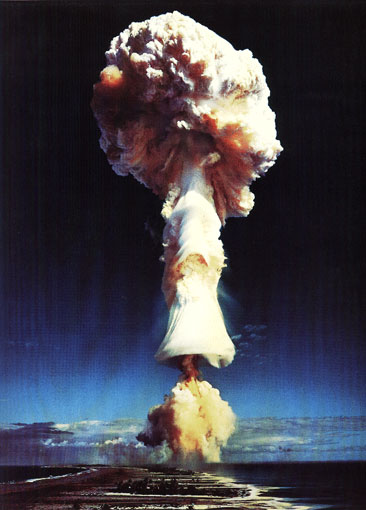Atomic and thermonuclear bombs
There are two types of nuclear bombs: the atomic A bombs and the thermonuclear hydrogen bombs known as H bombs. Atomic bombs became the first nuclear weapons to be used in war when the cities of Hiroshima and Nagasaki were bombed at the end of the Second World War. There is enough fissile matter (usually either uranium 235 or plutonium 239 enriched to over 90%) in the core of an atomic bomb to sustain a highly explosive chain reaction.
The far more powerful H bombs are powered by the process of nuclear fusion, where the fusion reactions are sparked off by the heat emitted by nuclear fission. Following experiments carried out in the 1950s and 60s on remote Pacific atolls or Siberian tundras, these terrifying weapons have fortunately never been used in war.

The atomic mushroom
Atmospheric nuclear test on Mururoa atoll in French Polynesia. The destructive power of nuclear weapons comes principally from the fireball and wind produced at the explosion moment. The majority of the radioactive dust is propelled into the stratosphere, where it will usually remain for a few years. This delay allows for most of the radiation to have disappeared by the time the dust falls back to Earth – accounting for a comparatively weak levels of radioactivity found on the Earth’s surface.
© CEA/DAM
The power of these bombs is measured in the number of kilotons or megatons (millions of tons) of trinitrotoluol (more commonly known as TNT) required to achieve the same effect. The bomb which destroyed Hiroshima on the 9th of August 1945 measured 21 kilotons, whereas the most powerful explosion ever produced by man was a Soviet H bomb dropped in 1961, and which measured 50 megatons.
Nuclear bombs release their energy in the form of a blast, a fireball, visible light and radioactive ionising rays. For a small bomb, 50% of its energy release comes from the blast, 35% through heat, and the remaining 15% in the form of radiation.
During the explosion and a few seconds after, the effects of neutrons and gamma rays, which are long range, is very intensive. Gamma radiation prevails for powerful bombs. Neutrons dominate the small bombs and neutron bombs.
Once the flash of gamma and neutron has passed off, the radioactivity comes from the dispersion of highly radioactive fission products and nuclei made radioactive by the flux of neutrons. The fallout in the area surrounding the explosion, however, is especially intense when the fireball hits the ground.
For bombs of under 100 kT, the radioactivity settles in the troposphere – the lowest layer of the atmosphere – and does not contaminate the ground for several weeks. Bombs of several megatons release 95% of their radiation into the stratosphere (at very high altitudes), where the radioactive particles can remain for up to seven years.
Other articles on the subject « Military Applications »
The 1945 A-bombs
Little Boy and Fatman The United States had available three bombs in July 1945: two made of pluto[...]
The Franck Report
The Scientists who opposed dropping atomic bombs on Japan In June 1945, shortly before the atomic[...]
Nagasaki
A Japanese account of the Nagasaki bomb Atomic bomb, rescue and relief report, a poignant small b[...]
Nagasaki First Aid
Extracts from Doctor Takashi Nagai first report In this first rescue report intended for the auth[...]
Atoms for Peace
1953: Eisenhower’s initiative for peaceful use of the atom After the Second World War, The [...]
Testing Nuclear Weapons
A practice that culminates in the 1950’s and 1960’s… The nuclear tests conducted by the sup[...]
Atomic Tests Fallout
An embarrassing legacy but alleviated with time Radioactive fallout differ significantly accordin[...]
Arsenals reduction
A modest step towards a reduction in nuclear arsenals During the Cold War, the United States and [...]